Judy Chicago is excited. ‘This morning my Instagram completely exploded!’ she tells me, clutching her iPhone, when we meet at her Santa Monica hotel. It is late September 2018, the day after Christine Blasey Ford’s devastating testimony, and Brett Kavanaugh’s subsequent tantrum, during the Senate Judiciary Committee confirmation hearings. A friend has forwarded Chicago an article on the website Bustle headlined ‘The Whole Country Just Watched What Happens When Angry, Powerful Men Don’t Get Their Way’, in which the faces of Kavanaugh, Lindsey Graham and Chuck Grassley were shown as a triptych, contorted in what the writer described as ‘fury and condescension’.
On Instagram, Chicago screen-grabbed the photographs and placed them immediately above her own triptych painting Three Faces of Man, from the series PowerPlay (1985). The similarity was uncanny. ‘It is really sad to watch my paintings come true decades after they were created,’ she wrote. In just a few hours, the post has racked up more than 1,400 likes. (A few days later it will have twice as many again.) Chicago is somewhat incredulous, although social media is a new reality that the 79-year-old artist has swiftly come to embrace.
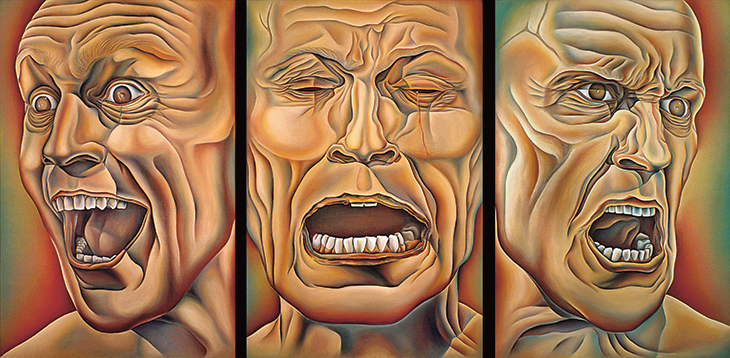
Three Faces of Man from ‘Power Play’ (1985), Judy Chicago, Palmer Museum of Art, Penn State University, Pennsylvania Photo: © Donald Woodman/ARS, New York; © Judy Chicago/Artists Rights Society (ARS), New York
‘I came up just like everybody else,’ she says, ‘into the small LA art community, with this idea that there was a small audience for contemporary art. Then when The Dinner Party became the piece that everybody wanted to see, and nobody wanted to show, and people started organising around the world to get The Dinner Party to their town, and it went on this huge alternative tour to 16 venues, six countries, three continents, to a viewing audience of over a million people, that kind of exploded this myth about the small audience for contemporary art! It educated me to the potential power of art. There was no going back from that!’
Chicago’s audience continues to grow. We are meeting just before her career retrospective, ‘Judy Chicago: A Reckoning’, opens at ICA Miami (4 December 2018–21 April), for which she has refabricated her early pastel-painted minimalist sculpture Sunset Squares (1965), which she had destroyed when she could neither sell nor afford to store it. For the same exhibition, in February she will stage a new pyrotechnic smoke piece – the reason for her visit to Los Angeles from her home in New Mexico. The retrospective comes hot on the heels of an exhibition at the Villa Arson, Nice, titled ‘Los Angeles: The Cool Years’, which focused on work from the 1960s, recreating another lost installation, Feather Room (1965), a collaboration with Lloyd Hamrol and Eric Orr consisting of a bright white space filled knee-deep with white feathers. In summer 2018, selections from Birth Project (1980–85) – in which Chicago collaborated with 150 needleworkers to produce some 84 panels based on the experience of childbirth – filled the Pasadena Museum of California Art. Next autumn, a monograph published by Scala will coincide with an exhibition of her most recent project The End: A Meditation on Death and Extinction (2012–18), at the National Museum of Women in the Arts, Washington, D.C., and a simultaneous exhibition of early work at Jeffrey Deitch’s gallery in Los Angeles.
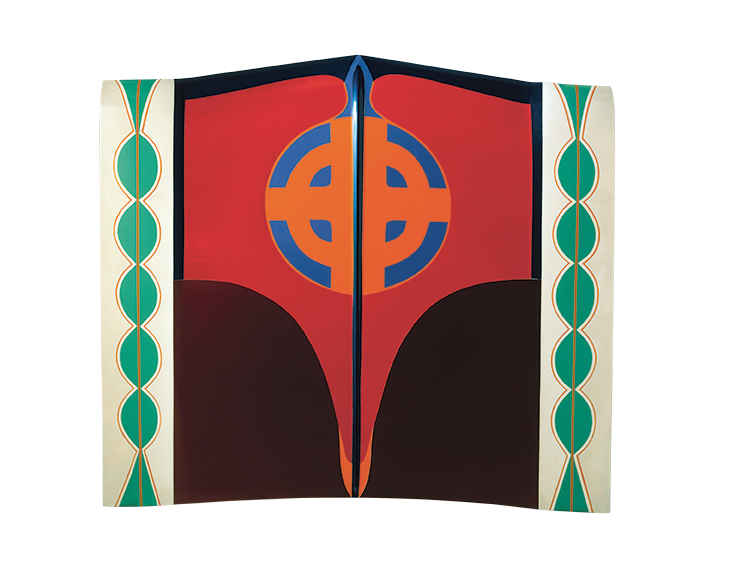
Car Hood (1964), Judy Chicago, Moderna Museet, Stockholm. Photo: © Donald Woodman/ARS, NY; © Judy Chicago/Artists Rights Society (ARS), New York
The Dinner Party (1974–79) remains the work for which Chicago is best known. A stupendously ambitious installation based on the conceit of an imaginary convocation of great women, The Dinner Party consists of a triangular table, set for 39 guests. Each place-setting includes a painted ceramic plate, a chalice, a napkin, a knife, fork and spoon, and an embroidered runner commemorating one of the mythical, fictional or historical figures summoned to the banquet. Sappho, Artemisia Gentileschi and Georgia O’Keeffe are among the better-known guests; many others, such as the 11th-century physician Trotula de Ruggerio, have been largely forgotten. (An early incarnation of the project was provisionally titled Twenty-five Women Who Were Eaten Alive.) During the five years of its creation, more than 400 volunteers, mostly women, collaborated with Chicago on the project at her studio in Santa Monica. Painters, needleworkers, ceramicists and historical researchers lent their skills, rewarded only by a shared sense of purpose and community, group discussions and potluck dinners.
Chicago was able to muster such support thanks, no doubt, to her prior involvement with grass-roots feminist organisations. When she began her career, in mid-1960s Los Angeles, she was miserably isolated. Always a tenacious competitor, she strived to go toe-to-toe with her male peers, a macho crew of artists associated with the Ferus Gallery and the car-body and surfboard aesthetics of Finish Fetish. Chicago – born Judy Cohen, then Judy Gerowitz after she married in 1961, and eventually self-named in 1970 after the city of her birth – wore heavy work boots and smoked cigars (which she hated). She drank at Barney’s Beanery with the boys (‘Then I went home and cried,’ she tells me). She enrolled at auto-body school to learn how to spray-paint, and at boat-building school to learn how to use fibreglass, and apprenticed as a pyrotechnician in order to use fireworks, until she was sexually harassed by her boss and gave up in despair. Each time, she was the only woman in the class. Chicago’s works from this period – such as her car bonnets painted with runic and anatomical imagery, or geometric canvases in sprayed pastel acrylic, or her firework happenings – are variously feminised incarnations of the dominant Finish Fetish, Light and Space, minimalist, Fluxus and Land Art tropes of the time. Even though she exhibited ambitiously scaled works at LA’s Rolf Nelson Gallery (and occasionally even sold them), she felt her progress thwarted at every turn, while she watched her male colleagues’ careers grow. ‘Eventually,’ she says, ‘I got tired of trying to be a guy!’
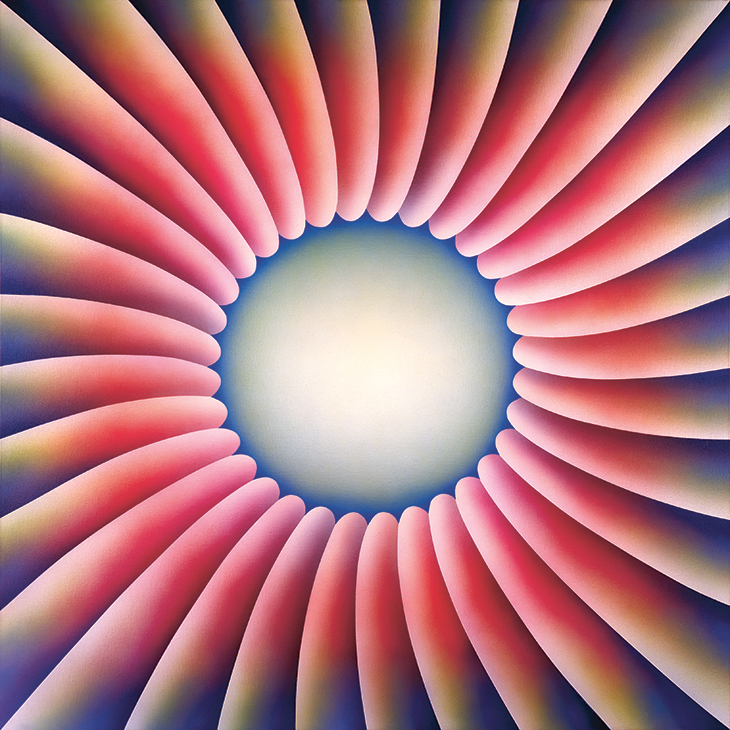
Through the Flower (1973), Judy Chicago Photo: © Donald Woodman/ARS, NY; © Judy Chicago/Artists Rights Society (ARS), New York
When she was invited to teach at Fresno State University in 1970, she taught a course about feminist art, exclusively for women. A year later she took the Feminist Art Program to CalArts, after the artist Miriam Schapiro visited Fresno and persuaded her younger colleague to join her as a teacher in Los Angeles. Chicago’s teaching methods were less concerned with formal art instruction than with consciousness-raising; any art that emerged as a consequence of the female participants’ self-empowerment was a bonus. Craft skills traditionally associated with the home, such as embroidery, quilting, knitting and baking, were reclaimed as valid forms of creative work that could be incorporated into art-making.
Schapiro and Chicago found a soon-to-be-demolished mansion on Mariposa Avenue in East Hollywood which, with their students, they renovated and reconceived as a feminist art installation. In January 1972 it opened as Womanhouse, a seminal example of a collaborative, immersive art environment. Participants, including Chicago and Schapiro themselves, created their own installations in rooms and cupboards throughout the house, and staged performances such as Chicago’s play Cock and Cunt. The intense audience and media response, as she later wrote in her second autobiography, Beyond the Flower (1996), contributed to ‘what I always knew would happen, which was that I was becoming famous’. A review in Time magazine – the first exposure that many of its readers would have had to feminist art – estimated that some 4,000 visitors filed through Womanhouse’s front door on its opening day.
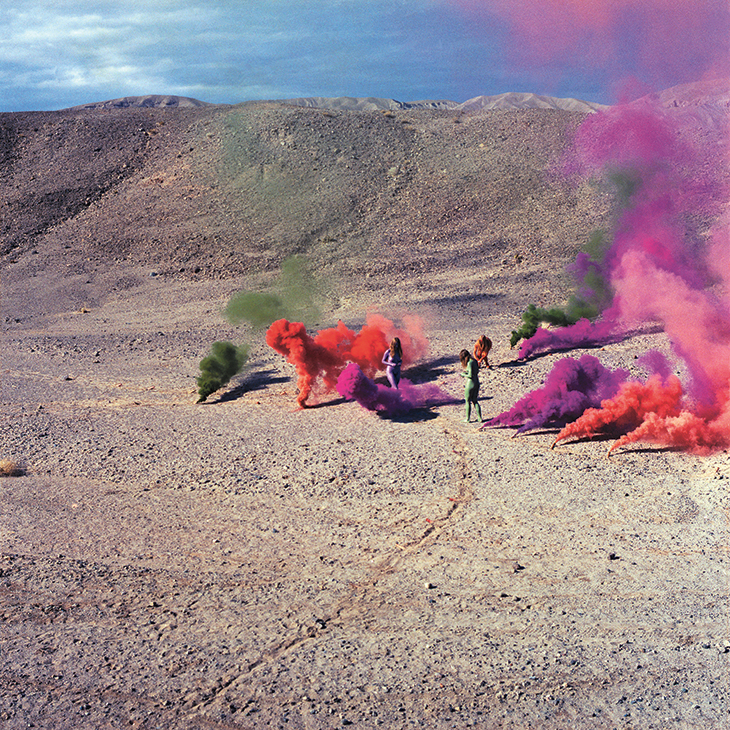
Smoke Bodies from ‘Women and Smoke’, photograph documenting performance in the California desert, (1972), Judy Chicago. Photo: photo courtesy Through the Flower Archives/the artist; Salon 94, New York; and Jessica Silverman Gallery, San Francisco; © Judy Chicago/Artists Rights Society (ARS), New York
Reading about the Feminist Art Program and Womanhouse today, however, it is clear that neither was a happy-clappy love-in. Participants complained of the long hours, the psychological pressure and physical demands placed on them by Chicago and Schapiro. The course leaders, moreover, had growing personal and philosophical differences of their own, and Chicago decided to quit. With art historian Arlene Raven and the graphic designer Sheila Levrant de Bretteville, she opened the Feminist Studio Workshop, an alternative art school which moved in 1973 into the newly established The Woman’s Building, a cooperative hub for feminist organisations. Once again, however, Chicago soon withdrew, finding the obligations and responsibilities of working with such a group overwhelming and distracting. She wrote in her journal that she was ‘on the brink of my major work’, and soon after retreated to the studio to concentrate wholly on what would become The Dinner Party. After nearly five years of work that almost drove Chicago to physical, psychological and financial ruination, The Dinner Party opened in March 1979 at the San Francisco Museum of Modern Art. More than 90,000 visitors came to see it, smashing the museum’s attendance records.
Not all sectors of the art world were enthusiastic. Reviews were decidedly mixed, and the work’s planned tour to the Memorial Art Gallery in Rochester and the Seattle Art Museum was cancelled, in the latter instance after the curator publicly stated that ‘I do not consider it fine art, but an interesting project by a group of women of whom the leader was an artist. I saw it more as a political statement than art.’ Perhaps the expressively painted vulvas on each of the plates – what Chicago catchily refers to as her ‘vagina china’ – were too much for certain delicate (male) eyes. Instead, grass-roots organisations began to come forward, offering to exhibit the work – an expensive and complicated undertaking. Over the next eight years it reached audiences all around the world. Then it languished, dismissed by many as politically anachronistic, essentialist about female identity, oblivious to non-white women, even aesthetically dubious. ‘Everybody tried to pretend it never happened, it wasn’t important, it was passé, feminism was passé, I was passé!’ says Chicago, adding, ‘Like, you wish!’ In 2007, after the work had been in storage for years, The Elizabeth A. Sackler Center for Feminist Art opened at the Brooklyn Museum with The Dinner Party as its permanent centrepiece.
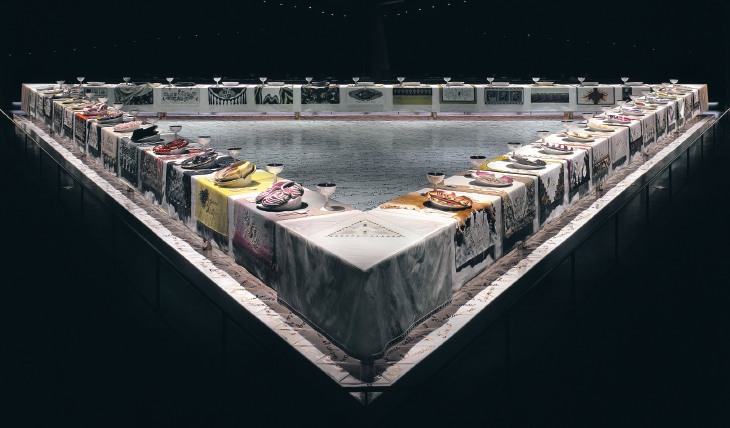
The Dinner Party (1974-79), Judy Chicago, Brooklyn Museum of Art, New York. Photo: Donald Woodman/ARS, NY; © Judy Chicago/Artist Rights Society (ARS), New York
This success story, if it can be called that, is the outcome of just one of many frustrating and arduous battles that Chicago has fought throughout her life. She remains impressively steadfast, unshakeably convinced of the importance and quality of her work. ‘I have a huge body of art – HUGE!’ she says. ‘And for a very long time, even though I was grateful for all the attention that The Dinner Party brought me, I used to say, “I hope I live long enough for people to understand that The Dinner Party is only one piece in a really big body of work.”’ The ICA Miami survey, she points out, covers only the first three decades of her career. It omits from the narrative important bodies of work such as Resolutions: A Stitch in Time (1994–2000), a series of needlework panels bearing Chicago’s reinterpretations of traditional proverbs; Kitty City (1999–2004), a series of watercolours and sculptures depicting the lives of her domestic feline companions; and the powerful Holocaust Project: From Darkness into Light (1985–93), a collaboration with her husband, the photographer Donald Woodman. After realising that they were both largely ignorant of their shared Jewish heritage, Chicago and Woodman embarked on a research project that led them to consider the genocide of Jews in Europe, as well as the cruelty and persecution inflicted by oppressive societies across the globe. The final installation, like many of Chicago’s projects, comprises many different pieces in different media, from sprayed acrylic on photographic prints to stained glass, tapestry, and exhibition didactics. ‘The art world has refused to look at the Holocaust Project,’ she says. ‘Yes, it had a tour, but in terms of having the kind of impact it’s intended to have, that hasn’t happened yet. But look how long it took people to see The Dinner Party!’
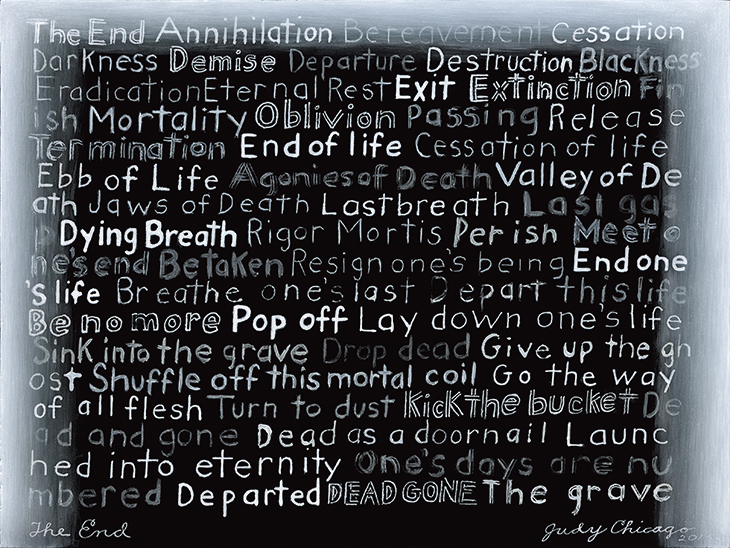
Title Panel: Mortality from ‘The End: A Meditation on Death and Extinction’ (2015), Judy Chicago. Photo: © Donald Woodman/ARS, NY; courtesy the artist; Salon 94, New York; and Jessica Silverman Gallery, San Francisco; © Judy Chicago/Artists Rights Society (ARS), New York
Her most recent project, The End: A Meditation on Death and Extinction, has been emotionally gruelling, she says. ‘One hundred million sharks are finned every year. Did you know that? They fin them alive and then they can’t swim, they can’t eat and they sink to the bottom of the ocean floor and they suffocate to death.’ (I later check this scarcely credible figure; not only is the estimate confirmed by a scientific study published in the journal Marine Policy in 2013, but it notes that the actual figure could be as high as 273 million.)
The seed of The End was planted in the 1980s when Chicago visited Auschwitz (with Woodman), where she learned that the assembly-line processes devised by the Nazis to exterminate the Jews were originally designed for pigs. ‘Where do you draw the line?’ she wondered. Her subsequent project, Kitty City, was an early reflection on interspecies relationships. ‘“Why is Judy drawing cats?”’ was the response at the time, according to the artist. ‘“How trivial!”’ When it is unveiled later this year, The End, for which Chicago developed a technique of painting on black glass in order to depict the end of her own life on Earth and the end of Earth itself, will perhaps make Kitty City seem like a more consequential work.
Given her unfair treatment by the art establishment, by her male peers and by men in general, does she hold grudges, I ask her. ‘No, I do not. I understand that we’re all brought up in the same system.’ She tells me a story about a conversation she had with Billy Al Bengston, perhaps the most notoriously unreformed of the Ferus dudes, and a long-time friend of Chicago’s. A few years ago, she said to him, ‘Billy Al, I never told you how much I learned from you.’ Bengston responded, ‘I know Judy, it was because I was such a male chauvinist that you did what you did.’ Chicago snapped back, ‘Don’t take all the credit!’
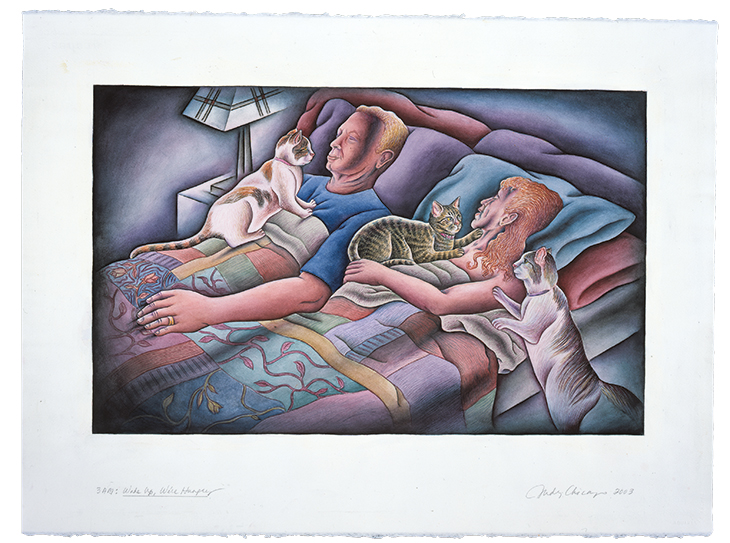
3AM: Wake Up We’re Hungry from ‘Kitty City’ (2003), Judy Chicago Photo: © Donald Woodman/ARS, NY; courtesy the artist; Salon 94, New York; and Jessica Silverman Gallery, San Francisco; © Judy Chicago/Artists Rights Society (ARS), New York
Chicago says that she refuses to feel sorry for herself. ‘I’m a student of history. I feel incredibly privileged and grateful that I’ve lived in the 21st century, in America, at a time when on our planet there are a lot of women who can’t go to school, who cannot work, who have to be covered up. They’re deprived of sexual experience and pleasure. I’m unbelievably fortunate! I think it’s very unseemly for privileged people like me to gripe. Yeah I’ve had a tough battle but you know what, the world’s a tough place, the world’s a tragic place. So “Get a fucking grip” is how I feel about griping.’
After spending six years making art about the end of the world, is it possible still to have hope for the future? How about after witnessing a supreme-court nominee accused of sexual misconduct being confirmed to the highest legal authority in the country (Kavanaugh has denied the allegations), while the sitting president (who has also been accused of sexual misconduct) lends his support? ‘I always have hope,’ Chicago says. ‘You have to choose hope. Hope comes from feeling that you’re on the side of right, and fighting for it. If you’re a passive observer to what’s going on, it’s easy to give in to despair. I’ve spent my whole life fighting for what I feel is right. It’s given my life meaning, and I hope it’s given some insights to other people. You have to choose hope.’
‘Judy Chicago: A Reckoning’ is at the Institute of Contemporary Art Miami until 21 April 2019.
From the January 2019 issue of Apollo. Preview and subscribe here.
Unlimited access from just $16 every 3 months
Subscribe to get unlimited and exclusive access to the top art stories, interviews and exhibition reviews.

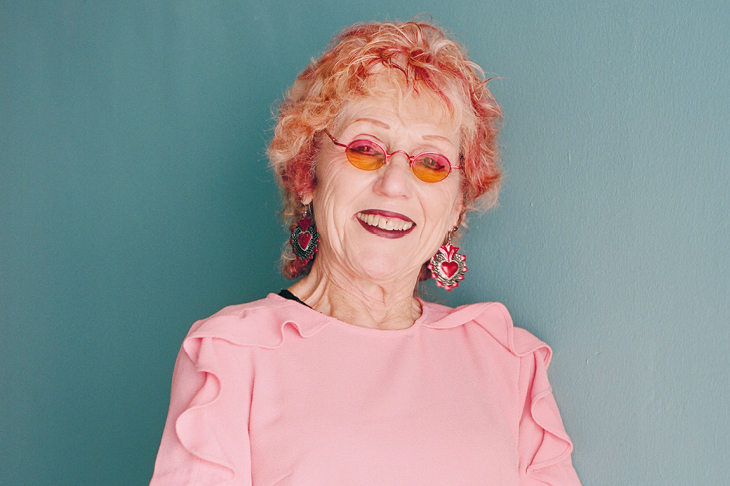
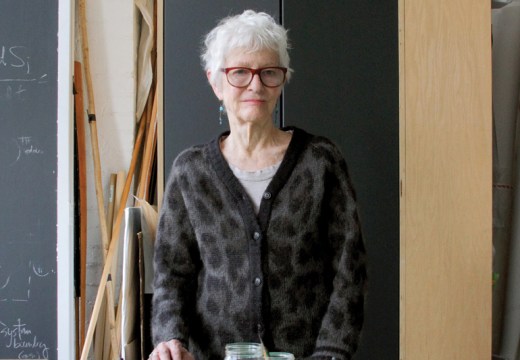
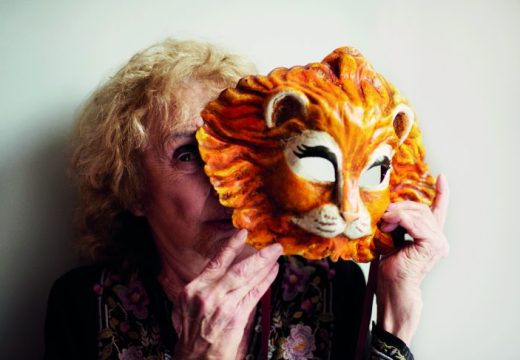
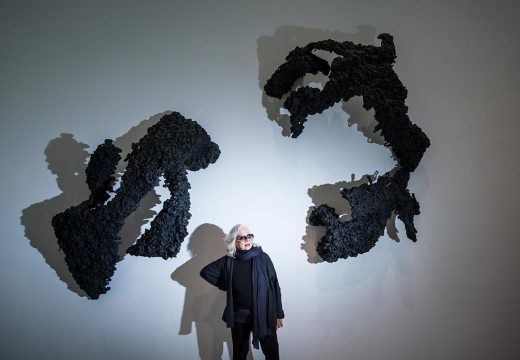









![Masterpiece [Re]discovery 2022. Photo: Ben Fisher Photography, courtesy of Masterpiece London](http://www.apollo-magazine.com/wp-content/uploads/2022/07/MPL2022_4263.jpg)
Why are fathers so absent from art history?